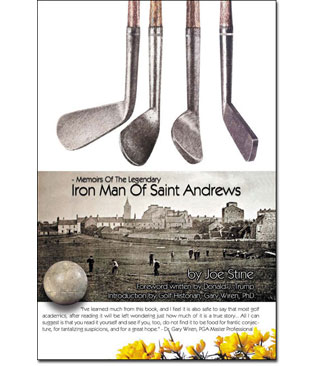 Available in Paperback, 254 Pages $17.99
Available in Paperback, 254 Pages $17.99
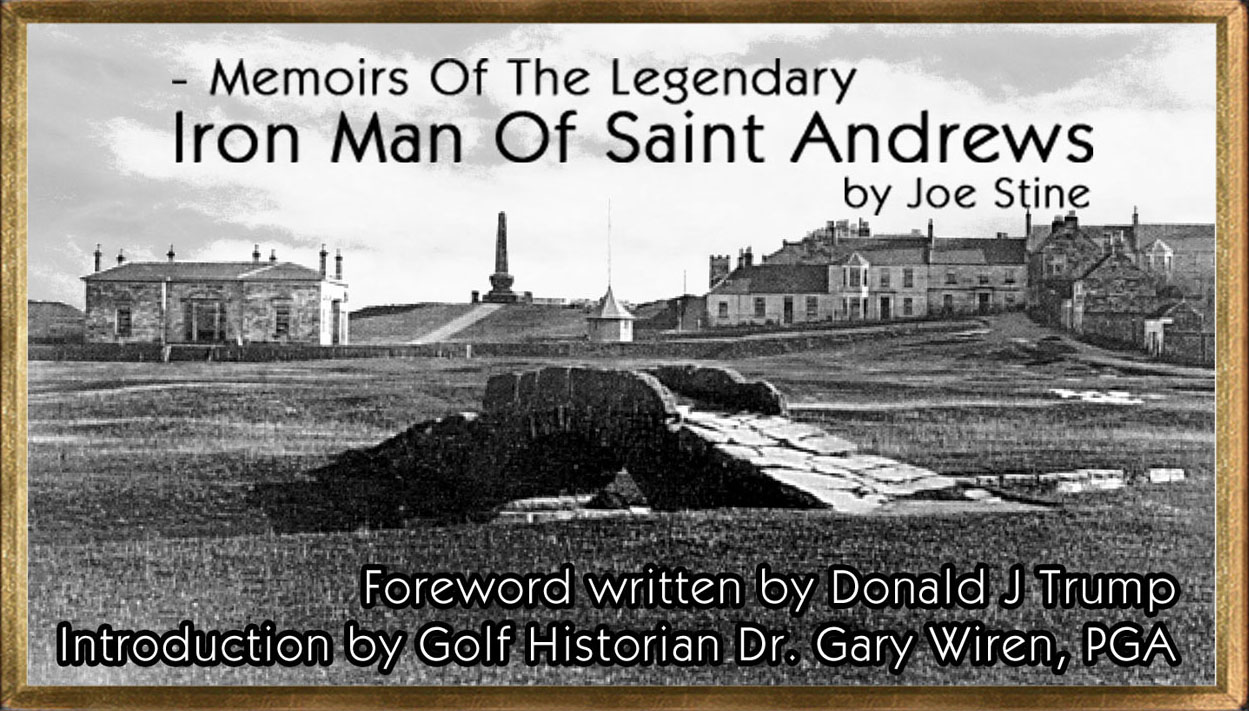
A Literary Treasure, 200 Years In The Making
Memoirs of the Legendary
Iron Man of Saint Andrews
Iron Man of Saint Andrews
A Literary Treasure, 200 Years In The Making
Chapter 10
Putter & Haggis, 1846

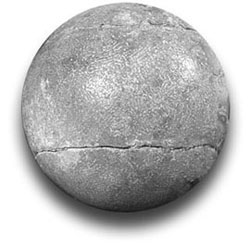
Twelve long and happy years after Alec Mackenzie's first lesson as a blacksmith’s apprentice, in the spring of 1846, the demand for golf balls was at an all-time high and the feather-ball business was very much at its zenith. By then, reputable ball-makers, such as Allan Robertson were selling to not only St. Andreans, but also exporting balls to America as well as other far-off destinations.

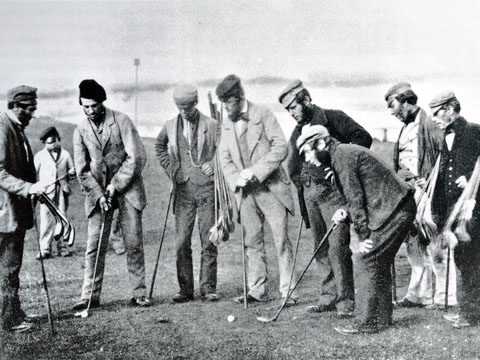 In 1846 the feather-ball business was very much at its zenith.
In 1846 the feather-ball business was very much at its zenith.
Still unbeknownst to the general public, Angus and Eamonn Mackenzie were supplying unmarked featheries of the highest quality to Robertson and a select few ball merchants of the region. Their wiley business strategy was still to stay small and work behind the scenes whilst letting the marketing experts do the selling, for they could charge a higher price than the Mackenzies could.
Still unbeknownst to the general public, Angus and Eamonn Mackenzie were supplying unmarked featheries of the highest quality to Robertson and a select few ball merchants of the region. Their wiley business strategy was still to stay small and work behind the scenes whilst letting the marketing experts do the selling, for they could charge a higher price than the Mackenzies could.
Allan Robertson once referred to the Mackenzies as St. Andrews’ best-kept secret. Other notable ball-makers from as far away as Musselburgh and Edinburgh, like the Gourlays, would also occasionally make the long trek to their obscure cottage on the outskirts of St. Andrews to buy the high-quality, unmarked feather balls by the bushel basket.
Other ball-makers would often sell feather balls made by their apprentices at a discounted price. These rejected balls, often too heavy or with inferior stitching, and usually poorly shaped, were considered to be good only for practicing. This was not the case with the Mackenzies, for they were still totally devoted to ball making in their little cottage up on the hill. It had been 15 long years since Alec made his first feather ball and during that time Angus and Eamonn had developed several additional labor-saving tools that not only saved time, but also increased the consistency of their featheries.

Their ingenious production techniques were still very much well-guarded family secrets; hence, they manufactured a much higher percentage of perfect featheries than their contemporaries could ever dream of making. Though it was still an arduous and labor-intensive process, virtually all of their feather-balls were considered perfect.
One evening around dusk, Angus and his then 25-year-old son, Alec, walked through the muddy, unpaved streets of St. Andrews after delivering balls to Hugh Philp’s shop. It was getting dark and the night was full of unsavory sights, sounds and smells. As they approached the Cross Keys Inn with its entrance lit by a gas street lamp, they saw a clergyman exit the front door. Although he was unknown to Angus and Alec, it was evident by his attire that he was in a religious order. At first glance, from far away they noticed nothing strange about this man of the cloth except for his size, for he was well over six-foot tall in a time when the average male Fifer was no more than five foot and seven inches.
The Cross Keys Inn was a respectable dining establishment for upper class St. Andreans, therefore, seeing a minister exit its front door shortly after dinnertime did not at all seem odd to them. He stopped and searched his vest and jacket pockets and then in a fit of drunken anger cursed with an English accent, “Damn it to hell! Where are those bloody spectacles?”
Angus and Alec looked at one another wide-eyed, as if shocked by the preacher’s foul language. At that moment a tiny grey kitten, no more than a couple of weeks old ran toward him from the shadows. Meowing at his feet as if begging for a scrap of food, the little feline could not have weighed more than a pound or two. In a fit of drunken rage the cleric whirled around and cursed at the little stray, “Get away, you unholy abomination!”
Then, without hesitation, he kicked the tiny kitten with the toe of his boot, hurling it against the building with a horrible thud. The young cat fell to the ground limp and unconscious. At that moment something in Alec snapped. He changed direction and walked up to the giant clergyman, saying, “You self-righteous English lout,” and then punched him squarely on the jaw, sending him to the ground like a three-hundred pound sack of dung.
Standing over him, Alec cited the Gospel of Saint Matthew, saying, “The Lord said that even a sparrow can not fall to the ground without God's notice. Perhaps you’ll remember that next time you mistreat one of God’s wee creatures, you pious fraud.” However, Alec was wasting his breath, because the drunken giant was unconscious.
Angus was stunned. For, that was a side of Alec that he did not know existed nor had he ever seen his son raise a hand toward another person. Angus could not believe that his son had just knocked out a three-hundred pound giant, a preacher no less, with one powerful blow.
Thinking fast, Angus swung his head in every direction, searching every window and doorway, looking to see if anyone had witnessed the incident. But he saw no one else. Then, he said to his son, who was still standing over the motionless body of the minister, “Fetch the wee cat, Alec! We’ll take it home to yer mum. She’ll know what to do.” Obeying his father, Alec quickly ran over, picked up the listless kitten, and put it in his coat pocket, and the two of them continued to walk hurriedly home.
When they reached home, Alec’s mother took care of the injured feline. Although badly bruised, the cat appeared to have no broken bones other than near the end of its wee tail. She put a splint on its tail, but it was to no avail. It would remain slightly crooked at the tip for the rest of its nine lives. It was a female kitten and the blow from the drunken giant’s boot had also seemed to have permanently damaged one of her eyes.
They adopted the rescued kitten with the crooked tail, and Angus named her Putter. The uncontrollable squinting of one of her green eyes in no way hampered her performance, nor her looks, for there was no denying that Putter was a bonnie kitten. Though her fur coat was silver grey, she did not look like a common alley cat, for her face and body were sleek and gaunt like that of a graceful Siamese.
As time passed, she became Angus’ cat, and spent most of her time in the workshop with him. Angus noticed how she faithfully followed him around all day long, as if she knew it was his quick thinking that rescued her. Occasionally, Putter would bring him a dead rat as a gift and leave it on the workbench for him to find. Angus would always encourage the cat by thanking her repeatedly before disposing of the rodent carcass. Six months later, she led a young mongrel dog into the workshop. Barely weaned, the tiny hound looked to be starving.
As Angus, Eamonn and Alec worked making featheries, Putter jumped up on the workbench as if she was proud of the wee young pup that she had led into the workshop. Angus looked at the cat, and then looked at the young dog. He then once again looked directly at the cat and asked, “Is that yer wee hoond?” At that very moment, Putter responded with a meow as if to concur.
Alec, who was sitting at his own workbench putting the final stitching on the leather cover of a freshly packed feather ball, laughed and said to his father, “Are you going to let her keep that mangy mongrel?”
Trying not to laugh, Angus scratched his head and pondered the situation for a moment. Looking at the little grey cat with the crooked tail, he then replied, “Putter has dedicated her life to bringing us a rat every day. Ah’d say that that kind o’ loyalty most certainly deserves loyalty in return. Besides, if we can have a cat, Ah dinna see why we shouldna let our cat have a dog. However, a good dog needs a good name, a name ye can sink yer teeth into.”
Eamonn spoke up and said, “Let’s call him Haggis!” Everyone agreed and Angus said, “Very well, Haggis it is!” He then rose from his stool, picked up his cup of tea that had feathers floating in it and proposed a toast, “Here’s to Putter and her dog, Haggis.” It was a happy time for everyone, especially for Haggis.
Alec did not know it at that time, but Putter and Haggis would eventually change the way he looked at life. He would come to realize that the stray cat and mongrel pup were more than just animals... much more, in fact. For above all, they were both sensitive, but especially the dog, Haggis. Alec would not come to understand just how very sensitive he was until eight long years later.
During that following year, Haggis grew tremendously, where as Putter stayed tiny. However, size was obviously irrelevant to the two animals, for most of the time Putter called the shots and Haggis followed her lead.
Since the ball-making business was good, Angus could afford to feed the two animals well and often fed them fish. Always well-fed, Putter preferred eating wild field mice and would often turn up her nose to fish parts. Haggis on the other hand, perhaps because of his ever-increasing size, would wolf down fishheads and entrails without hesitation.
The Mackenzies had a chicken-coupe in their back yard and usually kept at least a dozen egg-producing hens running loose around the little cottage. Haggis and Putter both considered the hens as pets. This became apparent to Alec one day when his father pointed out to him that neither the cat nor the dog would eat table scraps from a roasted chicken if one of their hens were missing.
Wild game was more to Haggis’ liking, and to this end he would often spend time foraging among the thorny gorse bushes that surrounded the links, stalking pheasant, grouse and the occasional hare (jackrabbit), which he would always bring home and share with Putter. Haggis was a successful hunter, and by the time he was nine months of age, he stood twenty-eight inches tall at the withers and weighed nearly eighty pounds. Putter on the other hand usually hunted for rats and mice closer to home and very seldom ventured onto the links. The little grey feline preferred dining on the tender field mice, and would most often leave the rats on Angus’ workbench as a present for her beloved master.
One sunny day Alec, his father and his grandfather, all sat on the back porch of their workshop overlooking the links, whilst they busily stuffed and stitched featheries. As they worked, they chatted and occasionally looked up to enjoy the view of the links. Every so often, they would look up long enough to watch a golfer or group of golfers play through and then return to stuffing and sewing featheries.
The blooms of thorny gorse that inundated the land surrounding the links looked like a sea of beautiful yellow flowers, and the broad masses of deep yellow had very much turned the old golf course into a veritable flower show.
Alec finished sewing the final stitches of a feathery, looked up, and noticed a golfer far off in the distance exercising a large dog down on the fairway of the links. This being a common occurrence on the links, he thought nothing of it as he reached for the little old telescope that was sitting next to his rocking chair.
As Alec raised the telescope to his eye, he remembered receiving it as a gift from his grandfather twenty years earlier. He remembered him saying, “Ye cinna be a proper pirate without a proper spyglass.”
Alec leaned back in his rocking chair to relax as he looked down toward the links through his telescope. He could see that even though the golfer down on the fairway was carrying a long-nosed wooden play-club, he was not playing golf. He was using it as a walking stick as he tried to keep up with his dog.
Alec watched as the dog flushed out, and then with incredible speed chased down a long-legged brown hare. A hare is larger than a common rabbit and can easily run at speeds of 45 miles per hour. The huge dog caught the hare with ease, shook it once and then carried the limp carcass to his master. The man took the dead hare, and rewarded the dog with a pat on the head. Then, when the dog was not looking, he threw the lifeless hare into the gorse bushes.
This wasteful killing was a distorted form of an ancient sport known as coursing, and this was a sight-hound. Sight-hounds such as greyhounds are hounds that primarily hunt by speed and sight, instead of by scent and endurance, as scent-hounds do. Bred to have keen vision, they are able to quickly detect motion, chase, capture and kill prey primarily by speed, but this shaggy giant was no greyhound.
Alec could tell that the dog was immense, and was unlike any dog that he had ever seen before. As the golfer walked between two familiar landmarks, Alec estimated that he was of average height. Therefore, by the way the dog’s height and girth dwarfed its master; he calculated the dog to be over three-feet tall at the shoulders and of an approximate weight of one hundred and thirty-five pounds.
Astounded by what he saw, Alec said, “That’s the biggest hound I’ve ever seen.” By that time, Eamonn had gotten curious and said to his grandson, “Gimme that spyglass, lad!” Alec handed the child-sized telescope to Eamonn, and the old man removed his spectacles and raised it to his eye. He looked down toward the links for a few moments and then said, “Tis a deerhound.”
Alec asked, “What’s a deerhound?” Answering his grandson, Eamonn said, “Tis a breed closely related to the wolfhound and has existed since before recorded history. The ancient Picts and Scots bred them to hunt hoofed game by coursing. ‘Coursing’ was a common hunting technique, practiced as far back as Alexander the Great.”
Eamonn continued, saying, “Nowadays, these hunting dugs have become sport’n animals for landowners and nobility. They’re fast and silent hunters and make quick work o’ any game from a hare up to the largest deer.” Still looking through the telescope, he then said, “It’s a good thing Haggis isn’t down there. That dug would surely kill him.”
Hearing that, Angus put down his tools and said, “Where is Haggis?” Eamonn scanned the links through the telescope and answered, “I dinna see him anywhere down there.” Then, Alec stood up and walked into the workshop to look for Haggis. He returned and said, “He’s not in the workshop.”
Angus rubbed his eyes as he took off his spectacles. From the vantage point of his rocking chair on the veranda, he could see the entire length of a footpath that cut through the tall thorny bushes to the links. He blinked repeatedly and then squinted his eyes as he tried hard to focus far off into the distance. Suddenly, Angus shot to his feet and pointing down the long path and exclaimed, “Is that Putter down there?”
Eamonn focused the telescope down the path, and there all of a hundred yards away he saw the little grey feline strolling home from the links proudly carrying a dead rat. Completely unaware of any impending danger, she was happy as a lark and walking at a normal pace.
Eamonn then focused the telescope back down toward the links and could see the giant deerhound stalking around the outskirts of the fairway. Then, as the dog happened upon the path that led up the hill it raised its head and looked up the distant hill toward the cottage as if it was looking right at Eamonn.
The giant dog stood perfectly still for a moment as it focused its eyes several hundred yards up the path. Eamonn held his breath as he watched Putter switch her tail as she continued to walk up the hill. At that moment, the dog tilted its head as if puzzled by the movement far off in the distance. Eamonn gasped as Putter switched her tail again and this time the dog’s ears went up as its keen eyesight zeroed in on the movement of her tail, then like a streak of lightning the dog started to run up the hill.
Eamonn cried out, “Guid God, he’s gaun after Putter!” Hearing that, Angus and Alec both jumped off the porch and started running down the hill toward the little grey cat. She was less than a hundred yards away from them but it may as well have been a mile, for the bloodthirsty deerhound was already running up the hill as fast as a racehorse.
Angus mis-stepped while running on the downhill slope and lost his footing. He painfully fell to the ground amongst the thorns of trampled gorse, but immediately scrambled to his feet and continued running. Alec on the other hand, kept his eyes on the deerhound and never slowed down.
The dog’s master was running behind the giant, yelling, “Windsor, no!” Nevertheless, the deerhound was a totally focused killing machine and very much like a greyhound chasing a rabbit, it could not be stopped.
Eamonn watched as the determined deerhound closed the gap, running straight up the path as fast as it could. Eamonn knew that Putter’s only chance was to get off of the path and run deep into the thorny gorse, but the little cat had no idea she was about to be pounced upon.
As Alec ran toward the little feline with all his might he yelled, “Run Putter, run!” Unfortunately, when Putter saw Alec and Angus running down the hill toward her she dropped the rat and just stood there, as if frozen with fright.
It became obvious that the deerhound was going to reach her before they were and Eamonn thought about closing his eyes, but he did not. In the stead, he instinctively prayed, “Dear merciful Lord in heaven, please save the wee cat, please save Putter. Please!”
The enormous deerhound closed the gap and lunged for Putter. But, at the last second a blurred object hit the deerhound broadside like a freight train, knocking it out of mid air with a horrific thud. The deerhound let out a yelp, as it had the air knocked out of its lungs. It was Haggis. He had caught wind of Putter’s predicament and was more than ready to risk his own life to save her.
Putter turned around, saw the two dogs, and shot into the thorny gorse to hide. The deerhound immediately rebounded and as a gruesome fight ensued, the air was filled with the most bloodcurdling sounds imaginable. Haggis instinctively went for the deerhound’s throat, but it was to no avail, for the deerhound was so large that it appeared hopeless for him.
By the time Alec had reached them, the deerhound was on top of Haggis and had a hold of him by the shoulders, trying to deliver the fatal bite to the neck. But Haggis’ thick fur coat deemed him a shaggy mouthful for the deerhound to hold.
Alec grabbed the back of the deerhound’s collar and pulled the dog off Haggis. The deerhound reared back its head for but a split second and bit Alec, delivering a grisly set of puncture wounds to his forearm. But the deerhound had made a tactical error in biting Haggis’ master, because within that same split second, Haggis got out from under the heavy giant. With the ferocity of a lion, Haggis grabbed the much larger deerhound by the throat, threw it to the ground, and hung on.
The two dogs fought relentlessly in what was sure to be a fight to the death for poor Haggis, until the deerhound’s master finally reached them and hit the deerhound in the ribs with his wooden play-club, screaming, “Windsor, no!” The giant dog yelped in pain and immediately took off, running down the hill. The fight was over.
Panting heavily, Haggis was exhausted, cut up and covered with blood. He walked to Alec’s side and sat. Alec stood, holding his bloody forearm as Angus walked to his son’s side and asked, “Are ye alright, Alec?” Alec replied to his father, saying, “My arm is numb.” Angus then put his arm around his son and walked him back up the hill. Haggis walked along with them and never left Alec’s side all the way back up the hill.
Alec’s mother bandaged his arm and said that it would be sore for a while but would heal without any complications. She cleaned Haggis’ wounds and said that he would also heal, though he now had several new battle scars. She said they gave him character.
The next day a member of the St. Andrews gentry came to the Mackenzie home to check on Alec. It was the owner of the deerhound. He apologized repeatedly for the incident and brought Alec a bottle of claret and a bottle of Scotch. Alec, Angus and Eamonn politely shared a wee nip of the Scotch with the man in the parlor of their home. He also asked about Haggis. Then to everyone’s amazement, the nobleman offered to buy Haggis from them for fifty pounds cash money on the spot.
Alec immediately spoke up for the dog and assured the nobleman that Haggis was part of the family and hence could not be bought for all the gold in St. Andrews. When he asked the gentleman why he wished to buy Haggis, the man said that Haggis had the heart and the nerve of a lion and he wished to breed him and use him as a fighting dog. Dogfights were considered an acceptable sporting event in 1846, and were quite common in Scotland.
Alec then asked the nobleman, “If you own several purebred fighting dogs, sir, why would you want to breed a mixed-breed mongrel like Haggis?” The nobleman poured himself another jigger of Scotch, and then drank it straight down, as if to fortify himself. For what he was about to say was difficult, almost demoralizing for him to admit. He then replied, “On more than one occasion, Ah have witnessed Windsor bite the neck and crush the spine o’ fighting dogs his own size. I have also seen him run down an elk and then kill it by crushing its throat with his powerful jaws. He is fully-grown, stands 34 inches tall at the withers, and weighs 135 pounds. Yet, yesterday your young, 80- pound mongrel nearly killed him in a fair fight.”
He continued by saying, “You’ve heard, I’m sure, the adage: ‘Tisna the size o’ the dog in the fight, but the size o’ the fight in the dog?’” “Yes, of course,” answered Alec. Then the nobleman said, “Your Haggis displayed far more heart than any dog I have ever witnessed.”
With that said, Alec took the nobleman to the back of the little cottage, and quietly opened the door leading to the workshop. The two of them stood silently in the doorway of the workshop and gazed in at Haggis, curled up on a throw rug on the floor, sleeping peacefully. And there on the floor, sharing the comfort of the soft rug with him, sleeping curled up right next to his now scarred face was the tiny grey cat.
Alec then whispered to the nobleman, “Haggis does have a big heart, but he only fought to save his best chum, Putter.”
Unbeknownst to Alec, Putter and Haggis would eventually change the way he looked at life. For he would come to realize that the stray cat and mongrel pup were more than just animals... much more, in fact. For above all, they were both sensitive, but especially the dog, Haggis. Alec would not come to understand just how very sensitive he was until eight long years later.


Table of Contents - 31 Chapters, 254 Pages
- Prologue – (Auction of the Circa 1800 ‘Ringmaker’ Iron)
- The Memoirs - The Wizard O’ The North, 1827
- Rosmairi Mackenzie & The Land O' Leal
- Learn’n Golf - The Game O’ Life (Old Course 1831)
- The Robertsons (Peter, Davie & Allan)
- Hugh Philp (The Stradivari of Clubmakers)
- Ball Mak’n (“Balls are whaur the money is.”)
- The Art O’ Club Mak’n
- The Apprentice, 1834 Blacksmith’n, “a vocation wi’ a future”
- Putter & Haggis, 1846
- Captain Mac 1846, Niver beat the landlord at golf
- The Ol’ Union Parlor, Tales of Chinese pirates & opium wars
- Rosmairi’s Gaelic Home, 1847 (Coontie O’ Ayrshire)
- Two Hole Course, Uncle Murdoch’s intro to golf
- Muireall McEwan’s 100th Birthday
- Turn’n O’ The Caber, (Anja)
- If It Isna Scotch, Tis Nae Whusky!
- Eat’n O’ The Haggis (haggis eat’n weary-whiddle)
- ‘The Day Efter’
- Master Cleekmaker
- Wi’ Birth Comes Death, 1848 (Winnie's Birth)
- Saint Andrews, 1852
- The Iron Man Visits Prestwick, 1854
- Death O’ Angus Mackenzie
- Test’n Cleeks Wi' Tom Morris
- The New Clubhouse at Saint Andrews, 1854
- A Wager Made
- The Golf Match (the Old Course in 1854)
- Home Hole
- The Golden Years
- Epilogue

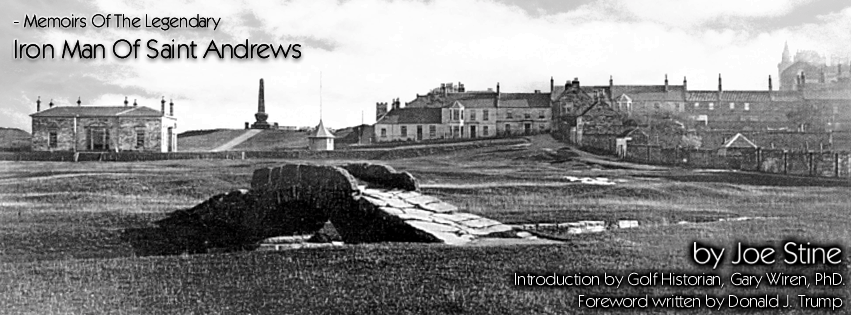
Available at Amazon.com
This historical novel presents a revealing look into the real history of 1800s Saint Andrews Scotland and its golfers. Based on real events, the 93,000-word memoirs entail a hauntingly in-depth account of the Iron Man's 89 well-spent years of life and golf within the enchanted royal burgh of his birth, beginning mid-June of 1827, when at age six, he and his six year-old best chum, wee Tom Morris met "The Wizard of the North," Sir Walter Scott beneath St. Rules Tower in the graveyard amongst the ruins of St. Andrews Cathedral.

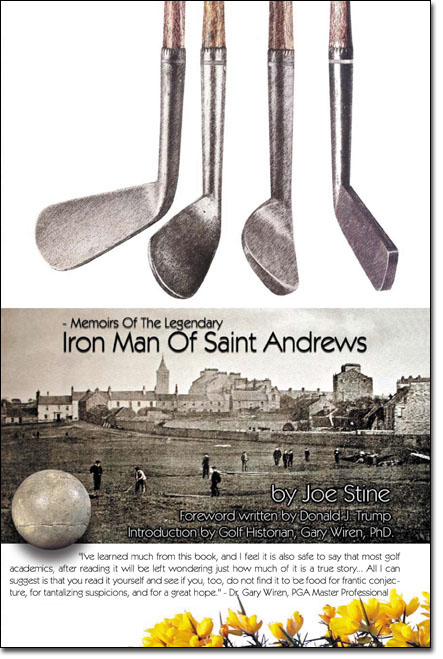
 Available on Kindle $12.99 at Amazon.com
Available on Kindle $12.99 at Amazon.com